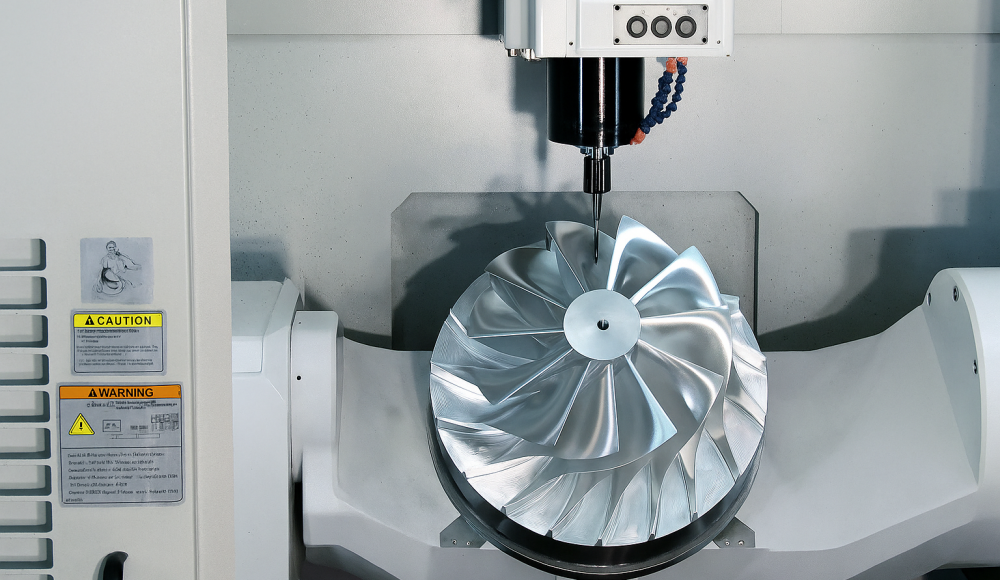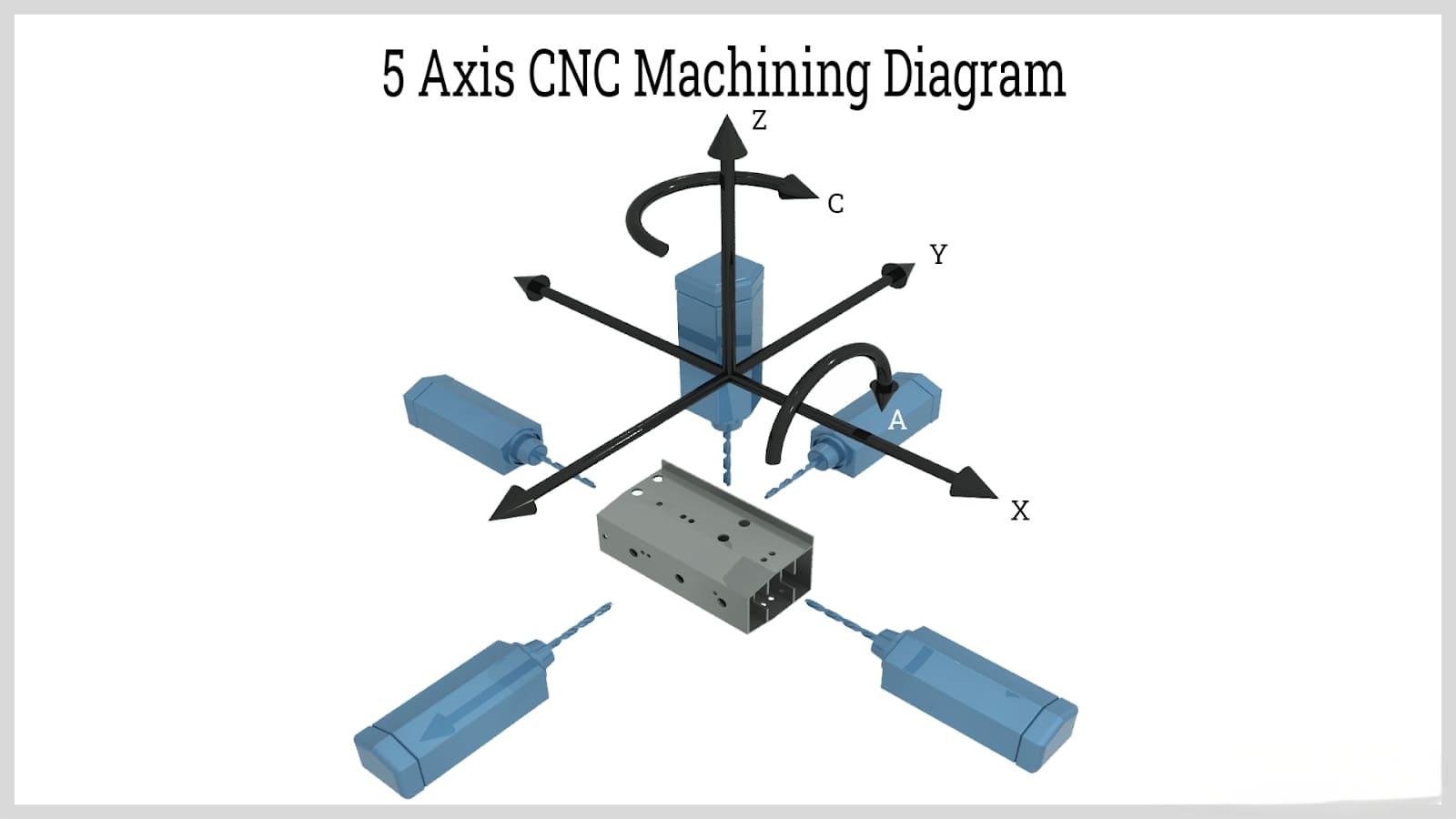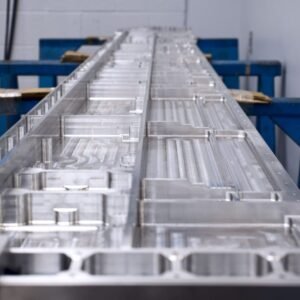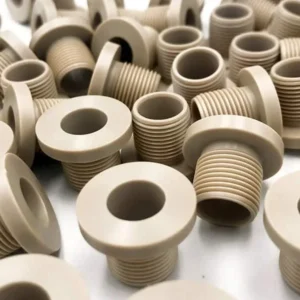Ao longo das décadas, Usinagem CNC Evoluiu de fábricas simples de três eixos para centros multiaxis altamente sofisticados. Hoje, A verdadeira usinagem de 5 eixos representa o auge da fabricação subtrativa, Combinando cinco eixos simultâneos de movimento para enfrentar as geometrias mais complexas em uma única configuração. Enquanto as impressões precoces dos centros de 5 eixos geralmente incluem "alto custo" ou "programação difícil,”Lojas modernas mostraram isso com o investimento certo em software, fixação, e treinamento, 5-A usinagem de eixo paga dividendos em precisão, velocidade, e projetar liberdade.
Este artigo fornece um mergulho profundo em 5-usinagem do eixo- Explicação de como funciona, as diferentes configurações de máquina que você encontrará, suas principais vantagens e desvantagens, e dicas práticas para aproveitar ao máximo esta poderosa tecnologia.
O que é usinagem de 5 eixos?
5-usinagem do eixo refere -se a operações do CNC nas quais a ferramenta de corte (ou a peça de trabalho) é capaz de se mover em cinco eixos independentes simultaneamente:
Eixo x: Esquerda/direita
Eixo y: front/traseiro
Eixo z: para cima/para baixo
Eixo a: rotação ao redor do eixo x
Eixo B.: rotação ao redor do eixo y
Combinando movimentos lineares (X, S, Z) com duas rotações (A, B), Uma verdadeira máquina de 5 eixos pode se aproximar de qualquer superfície em uma parte de praticamente qualquer orientação, eliminando a necessidade de descobrir e reiniciar a peça de trabalho para diferentes rostos.
Por que usar CNC para usinagem de 5 eixos?
Complexidade de uma sete
Acesse cinco rostos diferentes - top, fundo, e todos os lados - em uma operação contínua. Nenhum reposicionamento manual reduz o tempo de configuração e o potencial de erros.
Tolerâncias mais rígidas
Com menos configurações, Você elimina erros cumulativos de dados para dados. A maioria das lojas atinge ± 0,005 mm (0.0002″) repetibilidade em centros de 5 eixos.
Caminhos de ferramentas mais curtos
A ferramenta pode inclinar e girar para manter ângulos de corte ideais, Reduzindo o desgaste da ferramenta e vibração.
Voltação mais rápida
Peças complexas que antes exigiam acessórios especiais ou moagem secundária agora podem ser concluídos em uma única execução, Acelerando o tempo de mercado.
5-Fluxo de trabalho de usinagem CNC do eixo
Projeto CAD
Crie um modelo 3D totalmente definido, prestando atenção especial a superfícies críticas e reduções que apenas 5 eixos podem alcançar.
Programação de came & Simulação
Importar o modelo CAD para o software CAM. Gerar caminhos de ferramentas usando estratégias de 5 eixos (por exemplo., Swarf, Bolso de inclinação, rosto de vários lados) e simule para verificar se há colisões ou gobagens.
Geração de código G.
Após o processo, os caminhos de ferramentas do CAM em código G específico da máquina, incluindo movimentos coordenados de todos os cinco eixos.
Configuração da máquina & Fixação
Prenda a peça de trabalho em um acessório adequado (zero ponto, lápide, ou costume), e carregar ferramentas de corte necessárias no eixo.
Usinagem automatizada
Executar o programa sob supervisão mínima. Ajustes em voo podem ser feitos por meio de sondagem ou controle adaptativo.
Configurações de máquinas de 5 eixos
A. Cabeça/cabeça (Spinner Spinner)
O que é isso: Ambos os eixos rotativos extras estão na cabeça do eixo - pense na ferramenta de corte que faz todo o giro. A mesa sob sua parte fica parada.
Por que você escolheria: Você pode lidar muito grande, peças de trabalho pesadas porque a mesa não está se movendo. Ótimo para moldes gigantes ou vigas longas.
Relógio: A cabeça apenas inclina até agora, Portanto, alguns ângulos ainda podem estar fora de alcance.
B. Mesa/cabeça (Gire 'n' Tilt)
O que é isso: Um eixo rotativo está na tabela (Isso gira sua parte), E um está na cabeça (inclina a ferramenta). Você tem muito alcance sem mover toda a configuração.
Por que você escolheria: Super versátil - configuração mais comum. Você pode balançar sua parte em torno de quase 360 ° e ainda inclinar a ferramenta para ângulos complicados.
Relógio: A mesa giratória só pode segurar tanto peso, Portanto, há um limite no tamanho da peça.
C. Tabela/tabela (Rodar & Rodar)
O que é isso: Ambos os eixos extras vivem na mesa, Então sua peça de trabalho é a única coisa que gira. A cabeça fica colocada, movendo -se para cima/para baixo e lado/lado.
Por que você escolheria: Perfeito para sub-cuts e pontos super apertados-sua parte pode rolar sob a ferramenta de várias direções.
Relógio: Geralmente construído para menor, peças mais leves. Você tem menos espaço para balançar, E não é a configuração mais rápida.
Cada estilo tem seu ponto ideal: Cabeça/cabeça Para peças enormes, Mesa/cabeça Para flexibilidade geral, e Tabela/tabela Quando você precisa se esgueirar em todos os cantos e recantos. Sua escolha se resume ao tamanho da peça, forma, e quanto balanço e inclinação você realmente precisa.
Principais benefícios da usinagem de 5 eixos
Geometria Complexa
Superfícies esculpidas de máquinas - lâminas de trava, Impellers, implantes anatômicos - sem acessórios especiais.
Precisão & Repetibilidade
A definição única reduz os erros de reposicionamento; alcançar tolerâncias tão apertadas quanto ± 0,001 ″ de forma consistente.
Tempo de configuração reduzido
Cinco rostos em uma corrida de barra de barra e realinhamento manual.
Acabamento de superfície superior
Ferramentas curtas e ângulos de inclinação ideais minimizam a conversa e a deflexão da ferramenta, entregando RA < 0.4 Acabamentos µm.
Alta taxa de transferência
Movimento contínuo de cinco eixos, combinado com eixos de alta velocidade, Corta dramaticamente tempos de ciclo para peças complexas.
Desvantagens e considerações
Investimento de capital
5-Os centros de eixo custam 2-3 × mais do que as máquinas equivalentes de 3 eixos. Controladores e software especializados adicionam aos gastos iniciais.
Complexidade de programação
A cinemática multi-eixo exige estratégias de came avançadas e verificação completa de colisão.
Nível de habilidade do operador
Técnicos devem entender a cinemática de 5 eixos, fixação avançada, e rotinas de investigação - o treinamento aumenta os custos de mão -de -obra.
Tipos de peça ideais para usinagem de 5 eixos
Freeform & Superfícies esculpidas: Lâminas de turbina, implantes médicos, painéis do corpo automotivo.
Disco & Peças da placa: Quadros UAV, dissipadores de calor, tampas finais do motor com padrões de orifício radial.
Geometrias do tipo caixa: Gabinetes, caixas de velocidades, coletores que exigem acesso de várias caras.
Formas irregulares especiais: Suportes sub-cortados, Moldes contornados, dispositivos médicos em forma de orgânica.
5-Eixo vs.. 3+2-Usinagem de Eixos
Verdadeiro 5-eixos = suave, Movimento contínuo
A ferramenta (ou mesa) move todos os cinco eixos ao mesmo tempo, contínuo inclinar e girar enquanto ele corta.
Resultado: Você tem travessuras de ferramentas realmente fluidas, superfícies super lisas, e ciclos mais rápidos - sem parar e começar entre cortes.
3+2-Eixo = bloqueio, Inclinar, Corte
Pense nisso como um moinho de 3 eixos que pausas para inclinar a peça ou entrar em um novo ângulo (Esses são os eixos "+2"), Em seguida, trava tudo e corta.
Resultado: Você pode alcançar rostos angulares em menos configurações do que um eixo reto, Mas cada mudança de ângulo significa parar, reposicionamento, e depois retomar-então é mais lento e menos perfeito que o verdadeiro e 5 eixos.
Qual você deve escolher?
Vá 5 eixos Quando você precisa do mais rápido, Cortes mais precisos em curvas e sub-cuts complexos-ideais para peças aeroespaciais ou médicas de ponta.
Fique com 3+2 eixos Se você tem principalmente trabalho prismático com orifícios ou rostos angulares ocasionais, E você deseja economizar em custos de máquina e de programação.
Estratégias para maximizar o desempenho de 5 eixos
Escolha a suíte CAD/CAM certa
Procure detecção de colisão interna, Otimização avançada do caminho da ferramenta (estilo suíço, usinagem de repouso), e gêmeos digitais.
Invista em detecção de ferramentas & Sondagem
Automatize compensações de comprimento da ferramenta e configuração de peça para reduzir o erro humano e a velocidade de velocidade.
Aproveite o software de simulação
Execute simulações completas de máquinas, incluindo componentes de fixação, Para pegar colisões e otimizar o tempo do ciclo antes do chão da loja.
Aplicações do setor
Aeroespacial:
O que eles fazem: Lâminas de turbina, suportes de motor, Suportes de estrutura.
Por que 5 eixos ajuda: Aqueles curvilíneos, Peças de asa torcidas precisam de todos os ângulos em uma configuração. Sem segundas chances - os planos exigem ajustes perfeitos.
Médico & Dental:
O que eles fazem: Implantes de quadril, articulações do joelho, coroas dentárias personalizadas.
Por que 5 eixos ajuda: O corpo de todo paciente é único. 5-Axis permite que você esculpe essas formas orgânicas na primeira vez, Então as cirurgias correm bem.
Eletrônicos:
O que eles fazem: Afotos de calor, Altas da câmera, conectores de precisão.
Por que 5 eixos ajuda: Pequenos recursos e cantos apertados em placas de circuito? 5-Mills Axis fecha em torno deles sem perder uma batida.
Energia & Óleo & Gás:
O que eles fazem: Impeladores da bomba, corpos da válvula, colares de perfuração.
Por que 5 eixos ajuda: Peças neste mundo veem pressões e fluxos malucos. 5-O eixo garante suave, superfícies equilibradas que duram.
Automotivo & Corrida:
O que eles fazem: Rodas de turbocompressor, componentes de suspensão, coletores personalizados.
Por que 5 eixos ajuda: Os motores de alto desempenho precisam de caminhos de fluxo de ar e luz perfeitos, partes fortes-pregos de 5 eixos.
Ferramenta & Die Making:
O que eles fazem: Moldes para peças plásticas, Stamping morre, forjando blocos.
Por que 5 eixos ajuda: Cáries e undercuts complexos em uma única peça? 5-Eixo pode lidar com isso sem suar a camisa.
Arquitetura & Arte:
O que eles fazem: Fachadas esculpidas, arte de metal personalizado, painéis complexos.
Por que 5 eixos ajuda: Grande, formas sofisticadas com talento artístico? 5-O eixo transforma designs digitais em fatores WOW do mundo real.
Conclusão
5-A usinagem de eixo é uma tecnologia transformadora para produzir, peças de tolerância apertada em menos configurações e com acabamentos superiores. Enquanto os custos iniciais e as demandas técnicas são maiores que para os centros de 3 eixos, As capacidades incomparáveis-e a economia de tempo e trabalho-fazem usinagem de 5 eixos uma pedra angular para fabricação avançada.
Selecionando cuidadosamente a configuração da máquina certa, investindo em software e treinamento, e aplicar as melhores práticas (sondagem, simulação, Detecção de ferramentas), Os fabricantes podem desbloquear todo o potencial do CNC de 5 eixos para entregar mais rápido, mais preciso, e soluções econômicas em uma ampla variedade de indústrias.
Perguntas frequentes
1º trimestre: Qual linguagem de programação faz máquinas CNC de 5 eixos?
Eles usam o código G estendido com comandos de vários eixos (por exemplo., A, B se move o eixo) gerado por pós-processadores CAM.
2º trimestre: Quais materiais podem ser usinados em centros de 5 eixos?
Praticamente qualquer alumínio, titânio, aço inoxidável, Plastics de engenharia (OLHADINHA, Nylon), compósitos, e mais.
3º trimestre: Como faço para escolher entre cabeça/cabeça, Mesa/cabeça, e configurações de tabela/tabela?
Baseie sua escolha no tamanho da peça, complexidade de fixação, e viagens rotativas necessárias:
Peças muito grandes → Cabeça/cabeça
Trabalho versátil de tamanho médio → Mesa/cabeça
Cortes inferiores & Peças pequenas complexas → Tabela/tabela
Leia mais:
5 Serviço de usinagem CNC de eixo
Gabaritos e acessórios: Tudo o que você precisa saber
Usinagem CNC de Protótipos: Tudo o que você precisa saber




